
Platystemon is a monotypic genus of flowering plants in the poppy family containing the single species Platystemon californicus, which is known by the common name creamcups. It is native to Oregon, California, Arizona, Utah and Baja California, and is found in open grasslands and sandy soils below 6,000 feet (1,800 m) elevation.
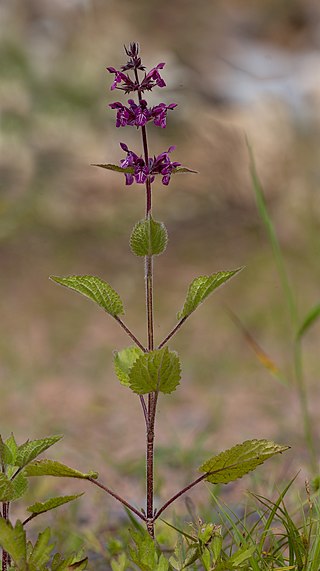
Stachys sylvatica, commonly known as hedge woundwort, whitespot, or sometimes as hedge nettle, is a perennial herbaceous plant growing to 80 cm (31 in) tall in woodland and unmanaged grassland. In temperate zones of the northern hemisphere it flowers in July and August. The flowers are purple. The leaves, when crushed or bruised, give off an unpleasant fetid smell.

Acanthomintha lanceolata is a species of flowering plant in the mint family known by the common name Santa Clara thornmint. It is endemic to California, where it is known from several counties surrounding and south of the San Francisco Bay Area. It is an uncommon resident of rocky habitat in coastal and inland mountain ranges.

Sairocarpus nuttallianus, commonly known as Nuttall's snapdragon or violet snapdragon, is a species of New World snapdragon.

Ceanothus dentatus is a species of shrub in the family Rhamnaceae known by the common name sandscrub ceanothus. It is endemic to California, where it is known only from the Central Coast and its Coast Ranges. It grows in coastal hills, bluffs, and canyons.
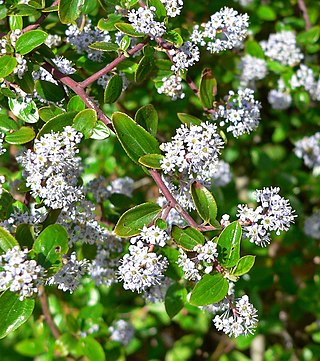
Ceanothus oliganthus is a species of shrub in the family Rhamnaceae known by the common name hairy ceanothus or hairy-leaf ceanothus.
Collinsia greenei is a species of flowering plant in the plantain family known by the common name Greene's blue-eyed Mary.

Hosackia stipularis, synonym Lotus stipularis, is a species of legume endemic to California. It is known by the common name balsam bird's-foot trefoil. It is found in most of the northern and central coastal and inland mountain ranges and foothills. It can be found in many types of habitat, including forest, chaparral, and disturbed areas. This is a mostly erect perennial herb with a leafy, often hairy and glandular form. Its slender branches are lined with leaves each made of several leaflets up to 2 centimeters long. The leaves sometimes have prominent stipules. The inflorescence is a compact array of up to 9 pink flowers. Each flower is elongated, the corolla borne in a tubular calyx of sepals, and the entire unit may exceed a centimeter long. The fruit is a legume pod 2 or 3 centimeters long containing several beanlike seeds.

Phacelia viscida is a species of phacelia known by the common names sticky phacelia and tacky phacelia.
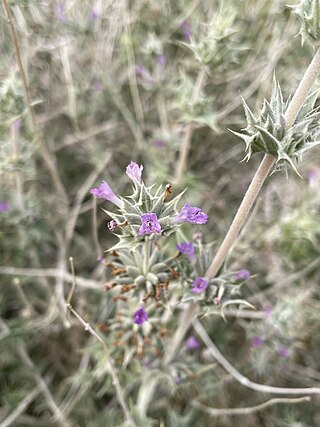
Salvia greatae is a species of flowering plant in the mint family, Lamiaceae. Its common names include Orocopia sage and lavender sage.
Scrophularia atrata is an uncommon species of flowering plant in the figwort family known by the common names black-flowered figwort and darkflowered figwort. It is endemic to California, where it is known only from a section of the Central Coast Ranges in San Luis Obispo and Santa Barbara Counties. It grows in the calcareous and diatomaceous soils of the coastal canyons at elevations not exceeding 500 meters. There have been 44 observed occurrences of this species, but perhaps 25 of these are historic and may no longer exist. This plant is a perennial herb producing an erect, four-sided stem up to a meter tall or slightly taller. It is somewhat hairy to densely woolly in texture. The leaves have toothed oval blades up to 10 centimeters long which are borne on long petioles. The inflorescence is a wide-open panicle with several hairy, glandular branches bearing flowers. The flower has an urn-shaped corolla with a rounded body and an open mouth at the top which is edged with hoodlike lobes. The corolla is deep, dark red to nearly black in color. The fruit is a capsule just under a centimeter long containing many seeds.

Acleisanthes nevadensis is a species of flowering plant in the four o'clock family known by the common names desert moonpod and desert wing-fruit. It is native to a section of the southwestern United States encompassing southern Nevada and adjacent corners of Utah and Arizona. One occurrence has been observed in eastern California. The plant grows in desert habitat such as scrub and rocky washes. This herb produces several spreading stems up to about 30 centimeters in maximum length, sometimes from a woody base. The stems are covered in many leaves with fleshy oval or rounded blades up to 3 centimeters long which are borne on petioles. The herbage of the plant is coated in thick, wide, white, furry hairs, interspersed with shorter, flat hairs. Some hairs are glandular. Flowers occur in leaf axils. Each is a trumpet-shaped bloom with a narrow, tubular green throat up to 4 centimeters long and a round white corolla face about a centimeter wide, sometimes tinged yellow or greenish. There are five long, protruding stamens and a long style tipped with a spherical stigma. The fruit is a ribbed, hairy body with five broad, white wings.
Silene marmorensis is a rare species of flowering plant in the family Caryophyllaceae known by the common names Marble Mountain catchfly, Marble Mountain campion, and Somes Bar campion. It is endemic to the southern Klamath Mountains of northern California, where it grows in mountain woodlands and forests. It is a perennial herb producing several stems and shoots from a woody, branching caudex and thick taproot. The hairy, glandular stems grow erect to a maximum height near 40 centimeters. The lance-shaped leaves are a few centimeters long and are borne in pairs, the lowermost drying early. The inflorescence is a terminal cyme of flowers at the top of the stem, and some flowers may occur in the leaf axils. Each flower has a hairy, veined calyx of fused sepals. The flowers bloom at night, the five pinkish or green-tinged petals opening at the tip of the calyx.

Stachys chamissonis is a species of flowering plant in the mint family known by the common name coastal hedgenettle. It is a perennial herb native to the west coast of North America, where it grows in moist coastal habitat from Alaska to central California. This mint produces an erect stem 1 to 2+1⁄2 meters. It is hairy, glandular, and aromatic. The oppositely arranged leaves have pointed, wavy-edged blades up to 18 centimeters (7.1 in) long which are borne on petioles. The hairy, glandular inflorescence is made up of interrupted clusters of up to six flowers each. The flower has a deep pink tubular corolla which can be over 3 centimeters (1.2 in) long. The corollas are borne in hairy calyces of purple or purple-tinged sepals.

Stachys pycnantha is a species of flowering plant in the mint family known by the common name shortspike hedgenettle. It is native to California, where it is known from many types of mountain and foothill habitat. This mint produces several stems usually exceeding 60 centimeters in height. It is hairy and glandular and very aromatic. The leaves have lance-shaped or oval blades borne on short petioles. The inflorescence is usually a single cluster or interrupted series of a few clusters of flowers, with up to 12 flowers per cluster. The tubular corolla is up to a centimeter long and white to pink in color. It is borne in a hairy calyx of sepals.
Trichostema parishii is a species of flowering plant in the mint family known by the common name Parish's bluecurls.
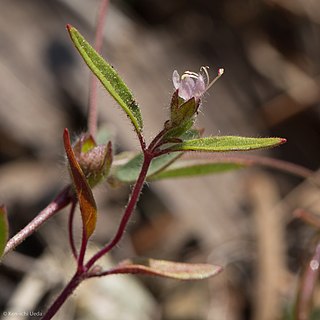
Trichostema simulatum is a species of flowering plant in the mint family known by the common name Siskiyou bluecurls.
Tripterocalyx crux-maltae is a species of flowering plant in the four o'clock family known by the common names Lassen sandverbena and Kellogg's sand-verbena.
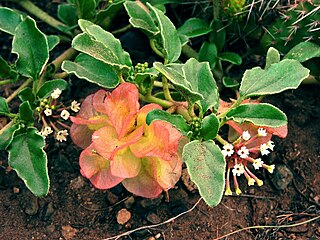
Tripterocalyx micranthus is a species of flowering plant in the four o'clock family known by the common names smallflower sandverbena and small-flowered sand-verbena.

Stachys floridana is a species of betony in the mint family, Lamiaceae. It is native to the United States, where its true native range is probably limited to Florida, but today it is known throughout the Southeast as an introduced species and common weed. It occurs as far west as Texas, and it has been recorded in California. Its common names include Florida betony, Florida hedgenettle, and rattlesnake weed. It has been called wild artichoke, but it is not closely related to artichoke. The plant was the Florida Department of Agriculture's "Weed of the Month" for February 2010.
















